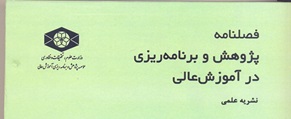اولویت بندی عوامل توانمندساز چابکی سازمانی در دانشگاهها و مراکز آموزش عالی شهر یزد
نویسندگان
1 کارشناس ارشد مدیریت صنعتی دانشگاه علم و هنر یزد، یزد، ایران
2 استاد دانشکده مدیریت و اقتصاد دانشگاه تربیت مدرس، تهران، ایران
3 استادیار دانشکده مدیریت دانشگاه علم و هنر یزد، یزد، ایران
چکیده
چابکی وسیلهای رقابتی برای همه سازمانهاست که امروزه، در محیط نامطمئن و در حال تغییر مطرح است. بسیاری از سازمانها در محیط رقابتی کنونی نیازمند برنامهریزی راهبردی برای رسیدن به چابکی هستند. در این خصوص، برای اجرای چابکی در سازمانها شناسایی عوامل توانمندساز چابکی سازمانی ضروری است، زیرا شناخت این عوامل میتواند به سازمانها در طراحی، برنامهریزی و اجرای چابکی یاری دهد؛ اما این عوامل اولویت یکسانی ندارند، مستقل از هم نیستند و وابستگیهای درونی دارند. از طرفی، دانشگاهها نیز بهعنوان یکی از سازمانهای دانشمحور نیازمند چابکی هستند. بنابراین، هدف این پژوهش شناسایی و اولویتبندی عوامل توانمندساز ساختاری چابکی سازمانی در دانشگاهها با استفاده از رویکرد مدلسازی ساختاری تفسیری بود. تحقیق حاضر از نظر هدف کاربردی و از نظر ماهیت و روش توصیفی- تحلیلی و ابزار جمعآوری اطلاعات پرسشنامه بود. جامعه آماری از دو بخش تشکیل شد. در بخش اول، بهمنظور شناسایی عوامل توانمندساز ساختاری چابکی سازمانی در دانشگاهها بر اساس منطق مدلهای تحلیل عاملی، نمونه 283 نفری از رئیسان، معاونان، مدیران گروهها و اعضای هیئتعلمی و مربیان دانشگاهها و مراکز آموزشعالی شهر یزد به روش نمونهگیری تصادفی طبقهای انتخاب، بررسی و تجزیه و تحلیل شد. در بخش دوم، بهمنظور سطحبندی و اولویتبندی عوامل کلیدی شناسایی شده، از دیدگاه 10 نفر از استادان دانشگاه که بر موضوع تحقیق تسلط علمی و عملی داشتند، بهره گرفته شد. نتایج تحلیل عاملی نشان داد که هفت عامل فرهنگ، تشکیل سازمان دانشمحور، نیروی کار چابک، بهبود مستمر، شراکت و همکاری جمعی، فناوری اطلاعات و ساختار سازمانی بهعنوان عوامل کلیدی توانمندساز ساختاری چابکی سازمانی در دانشگاهها بهشمار میروند. همچنین، نتایج مدلسازی ساختاری تفسیری نشان داد که عامل تشکیل سازمان دانشمحور بالاترین قدرت نفوذ و کمترین وابستگی را در بین شش عامل کلیدی دیگر دارد.
کلیدواژهها
عنوان مقاله [English]
Prioritizing factors enabling organizational agility in universities and centers of higher education in Yazd
نویسندگان [English]
- Seyed Ali Naghavi 1
- Adel Azar 2
- Mir Mohammad Asadi 3
1 Master of Industrial Management, Science and Arts University, Yazd, Iran
2 Professor of Management and Economics, Tarbiat Modares University, Tehran, Iran
3 Assistant Professor of Management, Science and Arts University, Yazd, Iran
چکیده [English]
Agility is a competitive means for all organizations that is considered important in today's uncertain and changing environment. In current competitive environment, many organizations need strategic planning to achieve agility. In this regard, for implementing agility in organizations, identifying factors enabling organizational agility is essential because understanding these factors can help organizations to design, plan and implement agility. But these factors do not have similar preference and have internal dependencies. On the other hand, universities as one of the knowledge based organization need agility. Therefore, the aim of this study was to identify and prioritize factors enabling structural organizational agility in universities via interpretive structural modeling approach. The aim of present study is practical and its method and nature is descriptive – analytical. A questionnaire was used to collect information. The statistical population consisted two parts. In first part, for identifying factors enabling organization agility structure, a sample of 283 individuals including presidents, vice presidents, department chairs, and faculty members and instructors in Yazd were selected according to random - stratified sampling and their opinions were evaluated an analyzed. In second part, for leveling and prioritizing identified key factors, 10 faculty members who had practical and scientific expertise about the issue were used. Factor analysis results showed that seven factors of culture, forming knowledge-based organizations, agile workforce, continuous improvement, participation and collective cooperation, information technology and organizational structure are considered as key factors enabling organization agility structure at the universities. Also, the results of interpretive-structural modeling showed that the factor of forming knowledge-based organization has the highest power and the least dependency among other 6 key factors.
کلیدواژهها [English]
- Higher Education
- Agility Enablers
- Interpretive Structural Modeling
- Iran
 فصلنامه پژوهش و برنامه ریزی در آموزش عالی
فصلنامه پژوهش و برنامه ریزی در آموزش عالی
